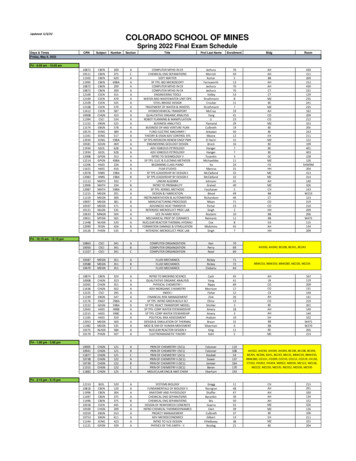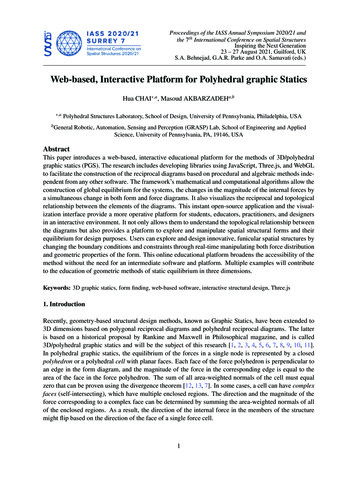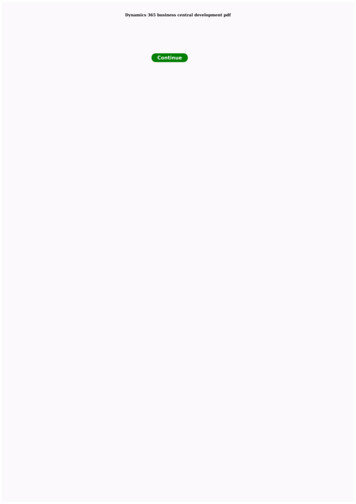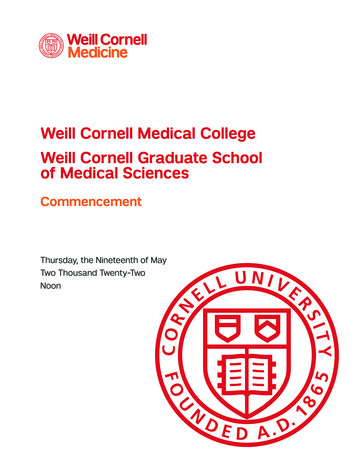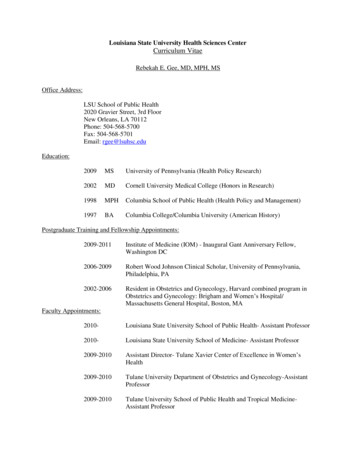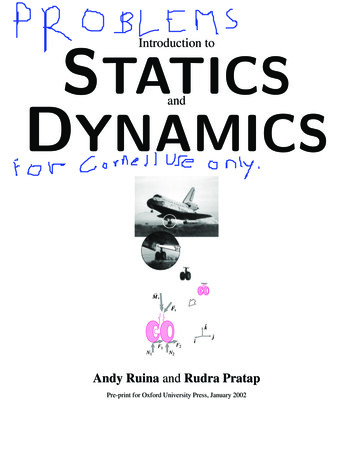
Transcription
Introduction toSTATICSDYNAMICSand Ms Fsk̂F2F1N1ı̂ ˆN2Andy Ruina and Rudra PratapPre-print for Oxford University Press, January 2002
c Rudra Pratap and Andy Ruina, 1994-2002. All rights reserved. No part of thisbook may be reproduced, stored in a retrieval system, or transmitted, in any formor by any means, electronic, mechanical, photocopying, or otherwise, without priorwritten permission of the authors.This book is a pre-release version of a book in progress for Oxford University Press.Acknowledgements. The following are amongst those who have helped with thisbook as editors, artists, tex programmers, advisors, critics or suggestors and creators of content: Alexa Barnes, Joseph Burns, Jason Cortell, Ivan Dobrianov, GaborDomokos, Max Donelan, Thu Dong, Gail Fish, Mike Fox, John Gibson, Robert Ghrist,Saptarsi Haldar, Dave Heimstra, Theresa Howley, Herbert Hui, Michael Marder,Elaina McCartney, Horst Nowacki, Arthur Ogawa, Kalpana Pratap, Richard Rand,Dane Quinn, Phoebus Rosakis, Les Schaeffer, Ishan Sharma, David Shipman, JillStartzell, Saskya van Nouhuys, Bill Zobrist. Mike Coleman worked extensively onthe text, wrote many of the examples and homework problems and created many ofthe figures. David Ho has drawn or improved most of the computer art work. Someof the homework problems are modifications from the Cornell’s Theoretical and Applied Mechanics archives and thus are due to T&AM faculty or their libraries in waysthat we do not know how to give proper attribution. Our editor Peter Gordon hasbeen patient and supportive for too many years. Many unlisted friends, colleagues,relatives, students, and anonymous reviewers have also made helpful suggestions.Software used to prepare this book includes TeXtures, BLUESKY’s implementationof LaTeX, Adobe Illustrator, Adobe Streamline, and MATLAB.Most recent text modifications on January 29, 2002.
722APPENDIX 1. Contact: friction and collisionsProblems for Chapter 1Introduction to mechanics Because nomathematical skills have been taught so far, thequestions below just demonstrate the ideas andvocabulary you should have gained from thereading.1.1 What is mechanics?1.2 Briefly define each of the words below (using rough English, not precise mathematicallanguage):a) Statics,b) Dynamics,c) Kinematics,d) Strength of materials,e) Force,f) Motion,g) Linear momentum,h) Angular momentum,i) A rigid body.1.3 This chapter says there are three “pillars”of mechanics of which the third is ‘Newton’s’laws, what are the other two?1.4 This book organizes the laws of mechanicsinto 4 basic laws numbered 0-III, not the standard ‘Newton’s three laws’. What are thesefour laws (in English, no equations needed)?1.5 Describe, as precisely as possible, a problem that is not mentioned in the book but whichis a mechanics problem. State which quantitiesare given and what is to be determined by themechanics solution.1.6 Describe an engineering problem which isnot a mechanics problem.1.7 About how old are Newton’s laws?1.8 Relativity and quantum mechanics haveoverthrown Newton’s laws. Why are engineersstill using them?1.9 Computation is part of modern engineering.a) What are the three primary computerskills you will need for doing problemsin this book?b) Give examples of each (different thanthe examples given).c) (optional) Do an example of each on acomputer.
Problems for Chapter 2723Problems for Chapter 2 2.8 Find the sum of forces F 1 20 Nı̂ 2 N ˆ , F 2 30 N( 1 ı̂ 1 ˆ ), and F 3 22 20 N( ı̂ 3 ˆ ).Vector skills for mechanics2.1 Vector notation and vector addition 2.9 The forces acting on a block of massm 5 kg are shown in the figure, whereF1 20 N, F2 50 N, and W mg. Find the sum F ( F 1 F 2 W )?2.1 Draw the vector r (5 m)ı̂ (5 m) ˆ . 2.2 A vector a is 2 m long and points northwest at an angle 60o from the north. Draw thevector.2.3 The position vector of a point B measures3 m and is directed at 40o from the negativex-axis towards the negative y-axis. Show theposition vector vector. 2.4 Draw a force vector that is given as F 2 Nı̂ 2 N ˆ 1 Nuk. 2.5 Represent the vector r 5 mı̂ 2 m ˆ inthree different ways.2.6 Which one of the following representations of the same vector F is wrong and why?b)-3 Nı̂ 2 N ˆ3Nı̂c) 2d)13 N 2313 N(Filename:pfigure2.vec1.2)2.7 There are exactly two representations thatdescribe the same vector in the following pictures. Match the correct pictures into pairs. ˆb)4Nc) 2 3Ne)3 Nı̂ 1 N ˆC problem 2.9:A(Filename:pfigure2.vec1.6)2 N(-ı̂ 2.11 Three forces F 2 Nı̂ 5 N ˆ , R 10 N(cos θ ı̂ sin θ ˆ ) and W 20 N ˆ , sumup to zero. Determine the angle θ and draw the force vector R clearly showing its direction. 2.13 Find the magnitudes of the forces F 1 30 Nı̂ 40 N ˆ and F 2 30 Nı̂ 40 N ˆ .Draw the two forces, representing them withtheir magnitudes.2.14 Two forces R 2 N(0.16ı̂ 0.80 ˆ ) and W 36 N ˆ act on a particle.Find the magnitude of the net force. What isthe direction of this force?2.15 In the figure shown, F1 100 N andF2 300 N. Find the magnitude and direction of F 2 F 1 .yF145o(Filename:pfigure2.vec1.7)2.18 In the figure shown below, the position vectors are r AB 3 ftk̂ , r BC 2 ft ˆ , and r CD 2 ft( ˆ k̂ ). Find the position vectorr AD .B3 N( 13 ı̂ ˆ)problem 2.7:(Filename:pfigure2.vec1.3)C r CDr ABDk̂A ˆproblem 2.18:(Filename:pfigure2.vec1.5)2.19 In the figure shown, a ball is suspendedwith a 0.8 mlong cord from a 2 mlong hoist OA. (a) Find the position vector r B of the ball.(b) Find the distance of the ball from theorigin.AyF2300.8 moxBproblem 2.15:(Filename:pfigure2.vec1.17)f)r BC 2.12 Given that R1 1 Nı̂ 1.5 N ˆ and R2 3.2 Nı̂ 0.4 N ˆ , find 2R1 5R2 .F 2 -F 13 ˆ)problem 2.17: 2.10 Given that the sum of four vectors F i , i 1 to 4, is zero, where F 1 20 Nı̂ , F 2 50 N ˆ , F 3 10 N( ı̂ ˆ ), find F 4 .30od)2Nı̂W4Nı̂ and r C/B 1 mı̂ 2 m ˆ , find r A/C .B3 30o3 ˆ2 )43 3problem 2.6:a)4 ˆ 2N ˆF22.17 Three position vectors are shown in the figure below. Given that r B/A 3 m( 12 ı̂ 2ma) F1(c) How far is A from B?2.16 Two points A and B are located in the x yplane. The coordinates of A and B are (4 mm,8 mm) and (90 mm, 6 mm), respectively. (a) Draw position vectors r A and r B . (b) Find the magnitude of r A and r B .45oOxproblem 2.19:(Filename:pfigure2.vec1.20)2.20 A cube of side 6 inis shown in the figure.
724APPENDIX 2. Contact: friction and collisionsyy (a) Find the position vector of point F, r F , from the vector sum r F r D r C/D r F/c .CT2 (b) Calculate r F . T160oB45o (c) Find r G using r F .zyExOCH hFDx30oproblem 2.23:GAproblem 2.20:Wproblem .vec1.27)xB (Filename:pfigure2.vec1.23)2.24 Express the vector r A 2 mı̂ 3 m ˆ 5 mk̂ in terms of its magnitude and a unit vectorindicating its direction.2.30 In the figure shown, rods AB and BC areeach 4 cm long and lie along y and x axes,respectively. Rod CD is in the x z plane andmakes an angle θ 30o with the x-axis. 2.21 Find the unit vector λ̂AB , directed frompoint A to point B shown in the figure.y3m 2.25 Let F 10 lbfı̂ 30 lbf ˆ and W 20 lbf ˆ . Find a unit vector in the direction of the net force F W , and express the the netforce in terms of the unit vector.(a) Find r AD in terms of the variable length .(b) Find and α such thatr AD r AB r BC α k̂ .B1m AzD2.26 Let λ̂1 0.80ı̂ 0.60 ˆ and λ̂2 0.5ı̂ 0.866 ˆ .2m1mxproblem 2.21:(a) Show that λ̂1 and λ̂2 are unit vectors.(b) Is the sum of these two unit vectors alsoa unit vector? If not, find a unit vectoralong the sum of λ̂1 and λ̂2 .(Filename:pfigure2.vec1.25)4 cmA30xproblem 2.30: Byo4 cmC(Filename:pfigure2.vec1.13)2.22 Find a unit vector along string BA andexpress the position vector of A with respect to B, r A/B , in terms of the unit vector.2.27 For the unit vectors λ̂1 and λ̂2 shownbelow, find the scalars α and β such that α λ̂2 3λ̂2 β ˆ .yy1A60o12.5 m1m3mx λ̂21.5 m2.31 In Problem 2.30, find such that the length of the position vector r AD is 6 cm.λ̂1xproblem 2.27:2.32 Let two forces P and Q act in the direction shown in the figure. You are allowed tochange the direction of the forces by changingthe angles α and θ while keeping the magnitudes fixed. What should be the values of αand θ if the magnitude of P Q has to be themaximum?y(Filename:pfigure2.vec1.11)Bzproblem 2.22:(Filename:pfigure2.vec1.26)2.28 If a mass slides from point A towards pointB along a straight path and the coordinates ofpoints A and B are (0 in, 5 in, 0 in) and (10 in,0 in, 10 in), respectively, find the unit vectorλ̂AB directed from A to B along the path.QPαθxproblem 2.32:(Filename:pfigure2.vec1.18)2.23 In the structure shown in the figure, 2 ft, h 1.5 ft. The force in the spring is F k r AB , where k 100 lbf/ ft. Finda unit vector λ̂AB along AB and calculate the spring force F F λ̂AB . 2.29 In the figure shown, T1 20 2 N, T2 40 N, and W is such that the sum of the threeforces equals zero. If W is doubled, find α and β such that α T1 , β T2 , and 2W still sum up tozero.2.33 A 1 m 1 m square board is supportedby two strings AE and BF. The tension in thestring BF is 20 N. Express this tension as avector.
Problems for Chapter 2725yk̂2.5 mQ name:pfigure2.vec1.21)2.36 Write the vectors F 1 30 Nı̂ 40 N ˆ 10 Nk̂ , F 2 20 N ˆ 2 Nk̂ , and F 3 10 Nı̂ 100 Nk̂ as a list of numbers (rowsor columns). Find the sum of the forces usinga computer. 2.34 The top of an L-shaped bar, shown in thefigure, is to be tied by strings AD and BD tothe points A and B in the yz plane. Find thelength of the strings AD and BD using vectorsr AD and r BD . 2.37 Let α F 1 β F 2 γ F 3 0 , where F1 , F2 , and F3 are as given in Problem 2.36.Solve for α, β, and γ using a computer. 2.38 Let r n 1 m(cos θn ı̂ sin θn ˆ ), whereθn θ0 n θ. Using a computer generatethe required vectors and find the sum44 r i , with θ 1o and θ0 45o .Bn 02m2.2 The dot product of twovectorsD 2.39 Find the dot product of a 2ı̂ 3 ˆ k̂ and b 2ı̂ ˆ 2k̂ .1mA 2.40 Find the dot product of F 0.5 Nı̂ 1.2 N ˆ 1.5 Nk̂ and λ̂ 0.8ı̂ 0.6 ˆ .30oxzproblem 2.34:(Filename:pfigure2.vec1.22) 2.41 Find the dot product F · r where F (5ı̂ 4 ˆ ) N and r ( 0.8ı̂ ˆ ) m . Drawthe two vectors and justify your answer for thedot product. 2.42 Two vectors, a 4 3ı̂ 12 ˆ and b ı̂ 3 ˆ are given. Find the dot product of thetwo vectors. How is a · b related to a b in this case? 2.35 A circular disk of radius 6 in is mountedon axle x-x at the end an L-shaped bar as shownin the figure. The disk is tipped 45o with thehorizontal bar AC. Two points, P and Q, aremarked on the rim of the plate; P directly parallel to the center C into the page, and Q at thehighest point above the center C. Taking thebase vectors ı̂ , ˆ , and k̂ as shown in the figure,find (a) the relative position vector r Q/P , (b) the magnitude r Q/P c1.24)problem 2.33:yxproblem 2.35:B1m D10oproblem 2.45:O1F 100 Nλ̂ 2.46 Find the angle between F 1 2 Nı̂ 5 N ˆ and F 2 2 Nı̂ 6 N ˆ . 2.47 Given ω 2 rad/sı̂ 3 rad/s ˆ , H 1 ˆ(20ı̂ 30 ) kg m2 / s and H 2 (10ı̂ 15 ˆ 6k̂ ) kg m2 / s, find (a) the angle between ω and H 1 and (b) the angle between ωand H 2 .2.48 The unit normal to a surface is given asn̂ 0.74ı̂ 0.67 ˆ . If the weight of a blockon this surface acts in the ˆ direction, findthe angle that a 1000 N normal force makeswith the direction of weight of the block.2.49 Vector algebra. For each equation belowstate whether:(a) The equation is nonsense. If so, why?(b) Is always true. Why? Give an example.(c) Is never true. Why? Give an example.(d) Is sometimes true. Give examples bothways.You may use trivial examples. 2.44 The position vector of a point A is r A 30 cmı̂ . Find the dot product of r A with λ̂ 32 ı̂ 12 ˆ .2.45 From the figure below, find the component of force F in the direction of λ̂. b) A b b A c) A · B B · A d) B /C B/C e) b/A b/A f) A (A·B )B (A·C )C (A·D )D2.50 Use the dot product to show ‘the law ofcosines’; i. e., 2.43 Find the dot product of two vectors F 10 lbfı̂ 20 lbf ˆ and λ̂ 0.8ı̂ 0.6 ˆ . Sketch F and λ̂ and show what their dot product represents. a) A B B Ac2 a 2 b2 2ab cos θ. (Hint: c a b ; also, c · c c · c )cbθaproblem 2.50:(Filename:pfigure.blue.2.1)
726APPENDIX 2. Contact: friction and collisions 2.51 Find the direction cosines of F 3 Nı̂ 4 N ˆ 5 Nk̂ .2.52 A force acting on a bead of mass m is given as F 20 lbfı̂ 22 lbf ˆ 12 lbfk̂ . What isthe angle between the force and the z-axis? 2.53 (a) Draw the vector r 3.5 inı̂ 3.5 in ˆ 4.95 ink̂ . (b) Find the angle this vector makes with the z-axis. (c) Find the anglethis vector makes with the x-y plane. 2.57 The net force acting on a particle is F 2 Nı̂ 10 N ˆ . Find the components of thisforce in another coordinate system with ba sis vectors ı̂ cos θ ı̂ sin θ ˆ and ˆ sin θ ı̂ cos θ ˆ . For θ 30o , sketch the vector F and show its components in the twocoordinate systems.2.58 Find the unit vectors ê R and êθ in terms ofı̂ and ˆ with the geometry shownin the figure. What are the components of W along ê R andêθ ?2.63 Write a computer program (or use acanned program) to find the dot product oftwo 3-D vectors. Test the program by computing the dot products ı̂ · ı̂ , ı̂ · ˆ , and ˆ · k̂ .Now use the program to find the components of F (2ı̂ 2 ˆ 3k̂ ) N along the liner AB (0.5ı̂ 0.2 ˆ 0.1k̂ ) m.2.64 What is the shortest distance betweenthe point A and the diagonal BC of the parallelepiped shown? (Use vector methods.)1BA2.54 In the figure shown, λ̂ and n̂ are unit vectors parallel and perpendicular to the surface AB, respectively. A force W 50 N ˆ acts on the block. Find the components of W alongλ̂ and blem 2.58:30oBOproblem 2.54:(Filename:pfigure2.vec1.41)2.55 Express the unit vectors n̂ and λ̂ in termsof ı̂ and ˆ shown in the figure. What are the x and y components of r 3.0 ftn̂ 1.5 ftλ̂? (Filename:pfigure2.vec1.44)2.59 Write the position vector of point P interms of λ̂1 and λ̂2 and (a) find the y-component of r P , ˆ 1xproblem 2.55:z6043mB1m2m30oyλ̂xproblem Filename:pfigure2.vec1.45)awhere λ̂ 0.30ı̂ 0.954 ˆ . Find the scalarequations parallel and perpendicular to λ̂.45ob45b(f)yb333(g)x b2 a 2.60 Let F 1 30 Nı̂ 40 N ˆ 10 Nk̂ , F 2 20 N ˆ 2 Nk̂ , and F 3 F3x ı̂ F3 y ˆ RF(ı̂ 3 ˆ ) (3ı̂ 6 ˆ ) 25 Nλ̂2545ox (e) y 2.62 A vector equation for the sum of forcesresults into the following equation:y 42.61 A force F is directed from point A(3,2,0)to point B(0,2,4). If the x-component of theforce is 120 N, find the y- and z-components of F .2m 105o32y3 ax b 4 ˆ Ay axF3z k̂ . If the sum of all these forces must equalzero, find the required scalar equations to solve for the components of F 3 .(b) along λ̂.oλ̂1 b(c) yproblem 2.59:(a) the y-axis, anda2λ̂2(Filename:efig1.2.27)2.56 From the figure shown, find the compo nents of vector r AB (you have to first find thisposition vector) along(b) P 2n̂ı̂(a) y(b) find the component of r P along λ̂1 .yθ2θ2.65 Find the cross product of the two vectorsshown in the figures below from the information given in the figures. yλ̂2.3 Cross product, moment,and moment about an axisêθλ̂ı̂3problem 2.64: ˆA ˆ C2(h) a2xy(-1,2) b(2,2)aa x3ı̂ ˆx(-1,-1)(2,-1)problem 2.65:(Filename:pfigure2.vec2.1)2.66 Vector algebra. For each equation belowstate whether:(a) The equation is nonsense. If so, why?(b) Is always true. Why? Give an example.
Problems for Chapter 2727(c) Is never true. Why? Give an example.(d) Is sometimes true. Give examples bothways.You may use trivial examples. a) B C C B b) B C C · B2.71 In the figure shown, OA AB 2 m. Theforce F 40 N acts perpendicular to the arm AB. Find the moment of F about O, given that θ 45o . If F always acts normal to the armAB, would increasing θ increase the magnitudeof the moment? In particular, what value of θwill give the largest moment?y F problem 2.74:c) C · (A B ) B · (C A) (Filename:pfigure2.vec2.8) θd) A (B C ) (A · C )B (A · B )CB A2.75 Find the sum of moments due to thetwo weights of the teeter-totter when the teetertotter is tipped at an angle θ from its verticalposition. Give your answer in terms of the variables shown in the figure. 2.67 What is the moment M produced by a 20N force F acting in the x direction with a lever arm of r (16 mm) ˆ ? AO2.68 Find the moment of the force shown onthe rod about point O.xproblem 2.71:F 20 Ny2.72 Calculate the moment of the 2 kNpayloadon the robot arm about (i) joint A, and (ii) jointB, if 1 0.8 m, 2 0.4 m, and 3 0.1 m.y45o2mα αθhBO W 3ACoO30 1x 2problem 2.68:(Filename:pfigure2.vec2.2)452.69Find the sum of moments of forcesW and T about the origin, given that W 100 N, T 120 N, 4 m, and θ 30o .OBoOA hAB AC C2 kNT /2(Filename:pfigure2.vec2.6)2.76 Find the percentage error in computing the moment of W about the pivot point O asa function of θ , if the weight is assumed to actnormal to the arm OA (a good approximationwhen θ is very small).a) the point of the ring attachment to theboard (point B), andWθxproblem 2.69:(Filename:pfigure2.vec2.9)problem 2.72:2.73 During a slam-dunk, a basketball playerpulls on the hoop with a 250 lbf at point C of thering as shown in the figure. Find the momentof the force about /2Wproblem 2.75:xyO (Filename:pfigure2.vec2.5)b) the root of the pole, point O.boardO AθWproblem .vec2.3)6"A2.70 Find the moment of the force1.5'3' Ba) about point Ab) about point O.10'F 50 Nbasketball hoop15o250 lbf2.78 Why did the chicken cross the road? 2.79 Carry out the following cross products indifferent ways and determine which methodtakes the least amount of time for you.α 30oO problem 2.73:1.5 m2.77 What do you get when you cross a vectorand a scalar? (Filename:pfigure2.vec2.7) a) r 2.0 ftı̂ 3.0 ft ˆ 1.5 ftk̂ ; F 0.3 lbfı̂ 1.0 lbfk̂ ; r F ? O2mAproblem 2.70:(Filename:pfigure2.vec2.4)2.74 During weight training, an athlete pullsa weight of 500 N with his arms pulling on ahandlebar connected to a universal machine bya cable. Find the moment of the force about theshoulder joint O in the configuration shown. b) r ( ı̂ 2.0 ˆ 0.4k̂ ) m; L (3.5 ˆ 2.0k̂ ) kg m/s; r L ? c) ω (ı̂ 1.5 ˆ ) rad/s; r (10ı̂ 2 ˆ 3k̂ ) in; ω r ?
728APPENDIX 2. Contact: friction and collisions 2.80 A force F 20 N ˆ 5 Nk̂ acts througha point A with coordinates (200 mm, 300 mm, -100 mm). What is the moment M ( r F )of the force about the origin?2.81 Cross Product program Write a programthat will calculate cross products. The input tothe function should be the components of thetwo vectors and the output should be the components of the cross product. As a model, hereis a function file that calculates dot products inpseudo code.2.86 What is the distance d between the originand the line AB shown? (You may write your solution in terms of A and B before doing any arithmetic).z ˆde) What is the component of F 1 in thex-direction? 1xC5"y5"(Filename:pfigure.blue.1.3) Bxproblem 2.86:2.87 What is the perpendicular distance between the point A and the line BC shown?(There are at least 3 ways to do this using various vector products, how many ways can youfind?)yproblem 2.82:3(Filename:efig1.2.11) 2.83 If the magnitude of a force N normalto the surface ABCD in the figure is 1000 N, write N as a vector. zBAz0F2problem 2.87:(Filename:pfigure.blue.2.2)A 1m1mBx32CD1m1m1mA5mCBxh) Repeat the last problem using either adifferent reference point on the axis DCor the line of action OB. Does the solution agree? [Hint: it should.] ˆı̂ g) What is the moment of F 2 about theaxis DC? (The moment of a force aboutan axis parallel to the unit vector λ̂ is defined as Mλ λ̂·( r F ) where r isthe position of the point of applicationof the force relative to some point onthe axis. The result does not dependon which point on the axis is used or which point on the line of action of F is used.).zB f) What is r D O F 1 ? ( r D O r O/Dis the position of O relative to D.) 14" y D d) What is the angle AOB? BA AO2.82 Find a unit vector normal to the surfaceABCD shown in the figure.b) Find a unit vector in the direction OA.c) Write both F 1 and F 2 as the productof their magnitudes and unit vectors intheir directions. Ak̂%program definitionz(1) a(1)*b(1);z(2) a(2)*b(2);z(3) a(3)*b(3);w z(1) z(2) z(3); 1ı̂a) Find a unit vector in the direction OB.yproblem 2.83:2.88 Given a force, F 1 ( 3ı̂ 2 ˆ 5k̂ ) Nacting at a point P whose position is given byr P/O (4ı̂ 2 ˆ 7k̂ ) m, what is the moment about an axis through the origin O withdirection λ̂ 2 ˆ 1 ˆ ?55OF13my4mxDCproblem 2.90:(Filename:p1sp92)(Filename:efig1.2.12)2.84 The equation of a surface is given as z 2x y. Find a unit vector n̂ normal to thesurface.2.85 In the figure, a triangular plate ACB, attached to rod AB, rotates about the z-axis. Atthe instant shown, the plate makes an angle of60o with the x-axis. Find and draw a vectornormal to the surface ACB.zBa) Make a neat sketch of the vectors OA,OB, and AB.b) Find a unit vector in the direction ofOA, call it λ̂ O A . c) Find the force F which is 5N in sizeand is in the direction of OA.d) What is the angle between OA and OB?45o A e) What is r B O F ?C45ox2.89 Drawing vectors and computing withvectors. The point O is the origin. Point A hasx yz coordinates (0, 5, 12)m. Point B has x yzcoordinates (4, 5, 12)m.1my60oproblem 2.85:(Filename:efig1.2.14) f) What is the moment of F about a lineparallel to the z axis that goes throughthe point B?2.90 Vector Calculations and Geometry. The 5 N force F 1 is along the line OA. The 7 N force F 2 is along the line OB.2.91 A, B, and C are located by position vectors r A (1, 2, 3), r B (4, 5, 6), and r C (7, 8, 9).a) Use the vector dot product to find theangle B AC (A is at the vertex of thisangle).b) Use the vector cross product to find theangle BC A (C is at the vertex of thisangle).c) Find a unit vector perpendicular to theplane ABC.d) How far is the infinite line defined byAB from the origin? (That is, how closeis the closest point on this line to theorigin?)e) Is the origin co-planar with the pointsA, B, and C?2.92 Points A, B, and C in the figure define aplane.
Problems for Chapter 2729a) Find a unit normal vector to the plane. b) Find the distance from this infiniteplane to the point D. c) What are the coordinates of the pointon the plane closest to point D? z54B(3, 2, 5)1(0, 7, 4)D b) A 2ı̂ , C 15 ˆ 360k̂ B 3ı̂ 4 ˆ , D 2ı̂ 17 ˆ 37k̂ CAx(5, 2, 1)7(3, 4, 1)yproblem 2.92:(Filename:pfigure.s95q2)2.93 What point on the line that goes throughthe points (1,2,3) and (7,12,15) is closest to theorigin?2.94 What is the distance between oppositeedges of a regular tetrahedron with sides oflength 1 (there are many ways to solve thisproblem). 2.95 Consider the vector equation a A bB C with A, B , and C given. For the cases belowfind a and b if possible. If there are multiple solutions give at least 2. If there are no solutionsexplain why. e) A ı̂ 2 ˆ , B 2ı̂ 3 ˆ , C 3ı̂ 4 ˆ f) A π ı̂ e ˆ , B 2ı̂ 3 ˆ , C ı̂2.96 Consider the vector equation a A bB cC D yBθ30oAxC a) A ı̂ , B ˆ , C k̂ , D 2ı̂ 5 ˆ 10k̂ problem 2.100:(Filename:pfigure2.4.2Dp3) b) A ı̂ ˆ , B ı̂ ˆ , C k̂ , D 2ı̂ c) A ı̂ ˆ k̂ , B 2ı̂ ˆ k̂ , C ı̂ 2 ˆ k̂ , D 2ı̂ ˆ k̂ d) A 1ı̂ 2 ˆ 3k̂ , B 4ı̂ 5 ˆ 6k̂ , C 7ı̂ 8 ˆ 9k̂ , D 10k̂ e) A 1ı̂ 2 ˆ 3k̂ , B 4ı̂ 5 ˆ 6k̂ , C 7ı̂ 8 ˆ 9k̂ , D 10k̂2.98 The three forces shown in the figure are in equilibrium, i.e., T 1 T 2 F 0 . If F 10 N, find tensions T1 and T2 (magnitudes of T 1 and T 2 .yT1T230o 2.101 Let F 1 F 2 F 3 0 , where F 3 10 N(ı̂ ˆ ), and F 1 / F 1 0.250ı̂ 0.968 ˆ and F 2 / F 2 0.425ı̂ 0.905 ˆ . Find F 1 from a single scalar equation. 2.102 To evaluate the equationF m a for F Fx ı̂ some problem, a student writes(Fy 30 N) ˆ 50 Nk̂ in the x yz coordinate system, but a 2.5 m/s2 ı̂ 1.8 m/s2 ˆ az k̂ in a rotated x y z coordinate system. Ifı̂ cos 60o ı̂ sin 60o ˆ , ˆ sin 60o ı̂ xa) A ı̂ , C k̂ B ˆ , D 3ı̂ 4 ˆ 19k̂cos 60o ˆ and k̂ k̂ , find the scalar equationsfor the x , y , and z directions.2.103 A car travels straight north-east for awhile on a dirt road that leads to north-southhighway. The car travels on the highway duenorth for a while. When the driver stops, theGPS system installed in the car indicates thatcar 60 miles north and 30 miles east from thestarting point. Find the distance travelled onthe dirt road.Fproblem 2.98:(Filename:pfigure2.4.2Dp1) with A, B , C and D given. For the casesbelow find a if possible, there is no need tofind b and c. 2.100 Three vectors, A, B , and C, (shown in the figure) are such that A B C 0 . You are given that A A 8 and C C 5.Find angle θ . b) A ı̂ , B 2ı̂ , C 3ı̂ c) A ˆ , B 2 ˆ , C 3ı̂ d) A ı̂ ˆ , B ı̂ ˆ , C 2 ˆ (Filename:pfigure2.4.2Dp2) a) A ı̂ , B ˆ , C 3ı̂ 4 ˆ Cproblem 2.99:a A bB cC Dand thatxA2.97 In the problems below use matrix algebraon a computer to find a, b and c uniquely ifpossible. If not possible explain why not. Youare given that 2.4 Solving vector equations60o 45o d) A ı̂ ˆ k̂ , C 3ı̂ 4 ˆ 5k̂ B 2ı̂ 3 ˆ 4k̂ , D 4ı̂ 5 ˆ 7k̂ e) A 1ı̂ 2 ˆ 3k̂ , C 7ı̂ 8 ˆ 9k̂ , B 4ı̂ 5 ˆ 6k̂ , D ı̂ π ˆ ek̂43Bc) A k̂ , C ı̂ ˆ k̂ B ˆ k̂ , D ˆ25y2.99 Points A, B, and C are located in thex y plane as shown in the figure. For position vectors, we can write, r B r C/B r C . Find r B and r C/B if r C 10 m ı̂ .2.104 A particle is held at point P with thehelp of three strings PA, PB, and PC. Let the tensions in the three strings be T A , T B , and T C , respectively (so that T A acts along linePA and so on). The equilibrium of the particle requires that T A T B T C W 0 where W 10 N k̂ is the weight of the particle.Find the magnitudes of tensions in the threestrings.
730APPENDIX 2. Contact: friction and collisionsCan the student solve for F1 , F2 , and F3uniquely from these equations? 2.115 Replace the forces shown on the rectangular plate by a single equivalent force. Whereshould this equivalent force act on the plate andwhy?2.111 What is the solution to the set of equations:300 mmxxxx y z w y z w y z w y z w A0002?D200 mm6NBCproblem 2.104:(Filename:pfigure2.4.3D1) 2.105 You are given that F 1 F 2 F 3 5 kN ˆ where F 1 (2ı̂ 3 ˆ 4k̂ ) kN, F 2 (ı̂ 5k̂ ) kN. If the magnitude of F 3 is 20 kN, find the direction of F 3 .2.106 A plane intersects the x, y, and z axisat 3,4, and 5 respectively. What point on theplane is in the direction ı̂ 2 ˆ 3 ˆ from thepoint (10,10,10)? (Find the x, y and z components of the point.). These problems concernthe solution of simultaneous equations. Thesecould come from various vector equations.2.5 Equivalent force systemsand couples6N410 N8Na) F1 12 F2 1 F3 0C40 N100 Nproblem 2.112:(Filename:pfigure2.3.rp1)D2.113 Replace the forces acting on the particle of mass m shown in the figure by a singleequivalent force.0.5 mEproblem 2.116:(Filename:pfigure2.3.rp5)2TTT45o30om ˆ2.117 The three forces acting on the circularplate shown in the figure are equidistant fromthe center C. Find an equivalent force-couplesystem acting at point C.32Fmgı̂problem 2.113:C(Filename:pfigure2.3.rp2)2.114 Find the net force on the pulley due tothe belt tensions shown in the figure.FRF30oproblem 2.117:(Filename:pfigure2.3.rp6)50 N ˆ2b) 2F1 32 F2 0 c) 52 F2 2F3 0.B0.6 mb) 3x 6y (2r 1)z 32.110 An exam problem in statics has three unknown forces. A student writes the followingthree equations (he knows that he needs threeequations for three unknowns!) — one for theforce balance in the x-direction and the othertwo for the moment balance about two differentpoints.0.5 mAa) 5x 2r y z 2Find the solutions for r 3, 4.99, and 5.2.116 Three forces act on a Z-section ABCDEas shown in the figure. Point C lies in the middle of the vertical section BD. Find an equivalent force-couple system acting on the structureand make a sketch to show where it acts.60 Nb) 3x1 6x2 9x3 4.5c) 2x1 4x2 15x3 7.5.c) 2x (r 1)y 3r z 5.(Filename:pfigure2.3.rp4)ı̂1x 2y π z 11 0.32.109 Write computer commands (or a program) to solve for x, y and z from the following equations with r as an input variable.Your program should display an error messageif, for a particular r , the equations are not linearly independent.P3 ˆ2x 3y 5 0,y 2π z 21,a) x1 2x2 x3 305N2.112 Find the net force on the particle shownin the figure.2.107 Write the following equations in matrixform to solve for x, y, and z:2.108 Are the following equations linearly independent?4Nproblem 2.115:50 Nı̂problem 2.114:(Filename:pfigure2.3.rp3)2.118 The forces and the moment acting onpoint C of the frame ABC shown in the figure are C x 48 N, C y 40 N, and Mc 20 N·m. Find an equivalent force couple system at point B.
Problems for Chapter 2731a) Find some point r 2 , and force F 2 so that F 2 acting at r 2 is equivalent to F 1 and M1 acting at r 1 .MCB CyCCxb) Find all possible wrenches (combinations of point location, force and mo ment) equivalent to the system with F 1 and M1 acting at r 1 . 1.2 m1.5 ma funct
AB EF H G D C problem 2.20: (Filename:pfigure2.vec1.23) 2.21 Find the unit vector λˆ AB, directed from point A to point B shown in the figure. x y 1m 1m 2m 3m A B problem 2.21: (Filename:pfigure2.vec1.25) 2.22 Find a unit vector along string BA and express the position vector of A with respect to B, r A/B, in terms of the unit vector. x z .



